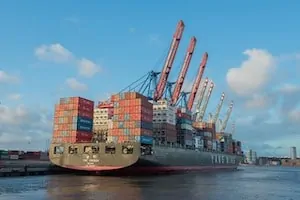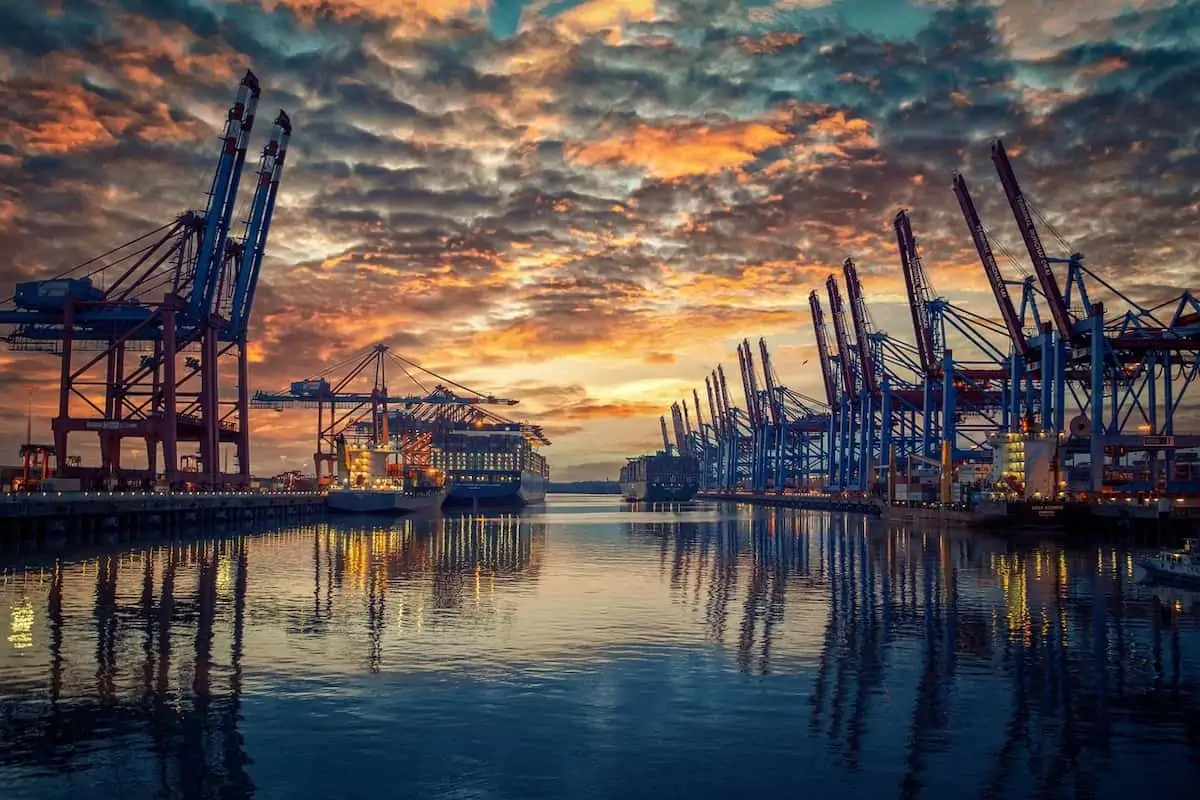Over the years, the explosion of trade around the world has resulted in the expansion of the infrastructure required to move goods around the world. There are several components to moving freight globally on container ships and independent firms compete for each portion of this traffic.
Transportation is a commodity so the only real factors for customers to consider are cost and time. Of course, you have to assume that in either case your goods will arrive safely, but any part of the logistics chain that can’t handle the freight without damage won’t stay in business for long.
The vast majority of global trade of consumer goods travels in ever larger container ships. Naturally, each portion of the supply chain will look for economies of scale wherever they can.
But bigger has its challenges and not every port can handle the bigger ships resulting in investments at port facilities in larger and larger cranes.
Where the customer goes, the supplier must follow. If you don’t have the equipment to unload a container ship, they simply can’t dock at your port. And if you can’t offload quickly, its costs them money.
When moving any freight, there are 4 components of cost. They are downtime, load time, travel time and unload time. Downtime and travel time are under the control of the ocean freight company, whereas they are at the mercy of the port facilities for load and unload times. You don’t make any money sitting in a port.

The current method of unloading container ships is to pull it into a dock and line up container cranes and start offloading containers one at a time. Need to go faster? Add another crane. Faster still? One more crane. But cranes also cost money and there is a limit to how many you can put alongside a container ship.
Container cranes have gotten bigger and faster over the years, but bigger and faster can only take you so far. As with most big leaps in productivity, perhaps it requires a completely different approach, and a marriage of alternate yet existing technologies.
A New Approach to Load/Unload Container Ships
Locks have been used forever in canals to raise and lower entire ships. Easy to do … they float!
What if instead of simply pulling up to a dock in a port, the container ship was able to pull into a lock? Lowering the entire ship means reducing the cycle time of each lift. How significant is this? On the largest ships, every second saved on a container would save 12 aggregate hours in total load/unload time.
At first glance, it would look like building a lock might exceed the potential savings. And an engineering study would be required to know for sure. But once you’ve put the ship in a lock, a very interesting thing has happened. You now have DRY LAND on either side of the ship, meaning you can load and unload from either side. Now, simply putting a container crane on either side of the ship isn’t going to help much, you could have just added another crane on the dock.
What if you don’t use a container crane at all? What if the ship pulls into the lock, and you are able to pull a gantry crane right over the top of the entire ship? The biggest gantry crane in the world will lift 20,000 tons, 45 ton containers are mere childs’ play for a gantry. But the limiting factor of a container crane is one hoist and one lift at a time. Except for space, there are no limits to how many hoists you can put on a gantry.
Now imagine four hoists on your gantry with two hoists working each side of the ship. While two are unloading off one side of the ship, the other two are picking 2 more containers off the ship and loading them onto container trucks. And because you have lowered the ship, the cycle time of each lift is reduced. One gantry crane has just replaced four container cranes, and is still able to do the job faster because of faster cycle times.
Trying to make faster and bigger container cranes can result in incremental efficiencies. Bigger improvements in productivity usually require a different approach. This approach has never been tried, and the author doesn’t have the cost equations to verify the possibilities.
Building a lock is more expensive, but you already have to build a deep sea port, so the cost of the lock would be incremental. I invite readers with more information to study the proposal, and perhaps trigger some ideas that would cause a leap forward in port efficiency.


Not sure about how to unload and load container ship faster, but I know that using a flat rate service to destuff your shipping containers is the fasted way to destuff and stuff your containers.
This is a great idea! It also mitigates risk as a gantry crane operator is working from two level surfaces. It should also be safer for the workers.
Also, this would allow for better organization of containers. Different ultimate destinations or service classes can be loaded on different shades of the vessel.
1 second isn’t much, but ,12 hours of less time to drop a container die to mechanical issue or operator error is significant!
You could also use a moveable platform that would raise the dock up to accomplish the same height difference such as a lock. Also you could unload half the container ship then move it to another port that can handle the higher draft of the semi-emptied ship. Then you are unloading twice as many ships.
Another process would be using a derrick barge and barges moored up to the container ship, and start unloading containers, then use tug boats to push the loaded barges to another port that could unload them with temporary crawler cranes onto trucks. This option would be costly, but what is the overall economic impact of all the goods that are waiting to be off loaded, the crews, etc…
Both the above options can be done immediately and not waiting to build a lock system which can take years of planning and even many more years to construct.
I gave this some thought based on your basic concept and found that the crane design could be improved fairly easily. This is entirely realistic:
Cycle time: 50 seconds (72 cycles per hour)
Normal lift: 10 containers per STS
For a Triple E class ship:
Cranes: 4
Unloading time: 3.25 hours
Technologies required: The STS cranes are a different configuration than what is currently used since they include a separate carrier platform and an elevator, but they are within the technological capability of current equipment. Your concept can work both with and without a lock, so a lock could be added if it decreased the overall cost of the process — or left out if not.
As we can see above, getting the containers off the ship wouldn’t be the main problem. Let’s look at intermediate transport. It typically takes one straddle carrier 3 minutes to get to the yard and back, so they would move 20 containers per hour. With 720 containers per STS crane per hour you would need 36 straddle carriers per crane compared to the current, 3-8 carriers per crane. With 4 stacks per crane, the RMG cranes can keep up even with a longer cycle time. However, the above STS rate would change that. You would need about 80 stacks per crane, and that is too wide since the increased distance would increase the cycle time for the straddle carriers. You might need 120 straddle carriers for each crane. That’s not going to work.
You would need some kind of new transport to move the containers farther from the ship, so that they could be handled with existing straddle carriers and yard cranes. I can’t think of anything that would work, but we could build something. A train car is too narrow, but we already have multi-bogey rail cars that go close to a million lbs, so we can adapt that. You use four tracks with four bogeys at each corner and build the carrier platform on top of that. Ten containers wide would be 80 feet. Let’s cut that down to 6 wide. Each car would be about 50 feet wide and 165 feet long. That would allow you to place 6 containers side by side in one operation which would easily fit within the 50 second cycle time. You could place four rows per car. So, each one would hold 24 containers. Let’s say we use four cars for 96 total containers. We then pull those out of the way and bring in four new cars. The problem though is that four cranes could load the train in 200 seconds while it could take 300 seconds to bring in a new train. That isn’t workable. Let’s try that again.
Let’s say we use 5 cars and only one crane on each side. That would be about 17 minutes to load with one crane. So, a 5-minute break to swap trains would still be 75% activity in each 22-minute cycle. That’s reasonable. Each train would carry 120 containers. No . . . that isn’t going to work. Okay, let’s cut the cars in half. Each car holds 12 containers, 5 cars per train with two trains in tandem. When the first train is loaded, it can move to the unloading area while the second one is loading. That’s more efficient. The loaded train then moves one row off at a time to a holding platform. It should be able to unload to all 10 platforms in 10 minutes, so that fits. Each platform would have 6 containers and at 3 minutes per cycle, one straddle carrier could move the containers to one stack in 18 minutes. The second train would go through a switch to the other side. So, that’s 20 platforms, 20 straddle carriers and 20 stacks with 2 RMG’s each so that they can load or unload at the opposite end. Once the second train is out of the way, you need to move two trains back in tandem, so we’ll need a third train to have another one ready. This is on each side of the ship, one STS crane per side, so that would be 40 platforms, 40 straddle carriers and 40 stacks total. That seems to be in the ballpark. Let’s see if this adds up:
6 containers every 50 seconds is 432 per hour, 75% activity cycle = 324
2 STS cranes = 648/hour
20 containers / hour x 40 carriers = 800/hour
We could unload a triple E in about 14 hours, so two 8-hour shifts should work. The process should work the same for loading.
The current system, using 4 STS cranes requires eight 8-hour shifts, so that would be 4x faster.
OK, here’s a really dumb question… couldn’t we just unload more than 1 container at a time? take them off in stacks? I know STS cranes would need to be beefier… but theoretically, if we could move 3-4 at a time and then just put the stack on to a ODR system to move to another location for stack and holding wouldn’t that work better?